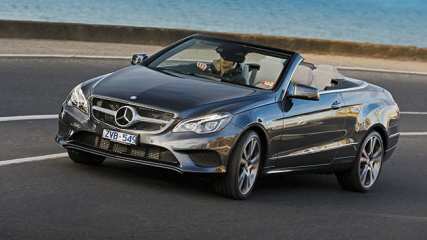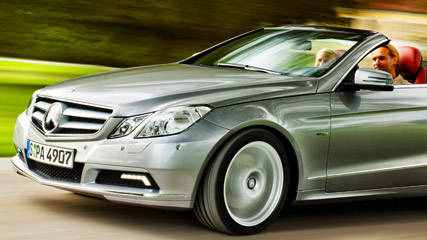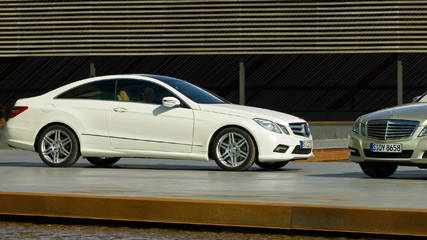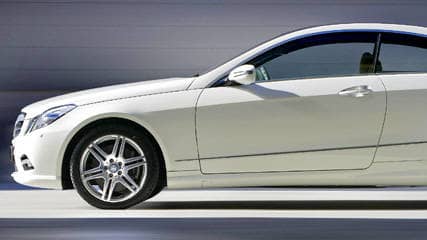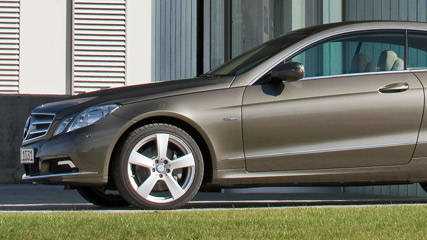Mercedes E-Class 2006 Review
By Paul Pottinger · 22 Sep 2006
The florid Yank leaned forward to emphasise his point, no mean feat given his girth."BMWs are fur the fellah whose makin' his money. Mercedes, on t'other hand, are fur the fellah whose made his money," he leered.This good ol' - and no doubt oil-rich - boy was how a certain Merc buyer was described (well, more or less) by a marketing bloke when I asked him to define the marque's demographic.Funny, because only the previous week in Brisbane, a limo driver said much the same thing, except he was talking of oil rich boys from the Middle East."Nah, mate," he said when asked if he'd consider a 7 Series or Audi's A8 to cart his clientele."When they're in town, it's Mercs or nothin'. Same with the Chinese."Stuggart cars remain those sought by the conspicuously status conscious; from those desperately seeking it (the rag trade tsarina double parking her C-Class outside a Surry Hills garment shop) to those who have long since acquired it (the Fortune 500 company CEO in his S 65 AMG).Some things change, but despite Merc's divergence into quaint urban shopping carts, the owner's statement of intent does not. Nor, to a vast extent, has the E Class, the Merc range which begins at a price point that excludes try-hards.The midlife facelift afforded this series of saloons (that's “sedans” to youse and me) and estates (and that's “wagons”) is much in the manner of the cosmetic procedure undergone by a likely owner. The E Class has been uplifted in some places, tightened in others and given a tasteful nose job nose.None of these will frighten the horses. Or the horsey for that matter ...Actually, it's in the equine department that the most significant additions of the claimed 2000 new or revisited E Class parts have been made. Enhanced engine outputs now range from 135kW for the previously anodyne E200K to 378kW for the barbarous E 63 AMG.Eleven variants have segued into showrooms - six saloons and five Estates - for the most varied model range in the executive segment.The most evident and successful gambits are the newly V-shaped grille, and sporty side skirts and bumpers on the Avantgarde (as opposed to Elegance) variants.Where vehicles of this rarefied strata are of most interest to us plebs is in terms of safety - the sort of measures that start in the rarefied reaches of the auto atmosphere and descends to cars we can afford.First of these in the revised E Class is Pre-Safe, a system which responds before an impending collision by activating front seatbelt tensioners and preparing airbag deployment. The second is Neck-Pro, a rear impact anticipator in which the sensors move head restraints forward to protect vulnerable upper spinal columns.May you never need either. What you will have more recourse to is the extra horses now summonable at a tap of the right foot.We drove the E 200K saloon, E 280 diesel saloon, E 350 Estate, E 500 Estate and the mighty E 63 AMG saloon - a back to back experience that reinforced each E Class iterant is entirely different and that there's surely one for all tastes.We'll revisit these soon and stick for now to the entrant E and the top of the conventional range.Driven through a five speed auto (the rest of the range of the sport uber smooth seven speeders), the 135kW/250Nm now in the E 200 K Classic makes the difference between a shetland and - if not a stallion - then a nicely behaved saddle pony.Supercharged or not, a 1.8 inline petrol four is only going to do so much with a 1.6 tonne car, but on a 100km drive at highway speeds (or what passes for them under fascist rule) from Melbourne into the boonies, it recorded an acceptable 7.7 litres.This car does not rock. It's not meant to. For $84,500, it does get you into the E Class without you feeling as though you've lobbed to a white tie event in hired evening wear.Altogether madder, the E 500 now hosts the 5.5-litre V8 from the S-Class - a thumping up-provement from the previous 5.0. With an output of 285kW and 530 Isaacs, it's capable of getting the 1.78 tonne saloon (the estate's 100kg heavier) to 100kmh from standing in a claimed 5.3 seconds.That's 0.7 seconds faster than the previous E 500 and feels every tenth of it.Driving the $166,300 estate (the saloon is $6K less) on narrow downhill twisties, was to wonder quite how something of such heft remains so pliant. Even with eight pots between your feet and the big E's newly nipped nose, the reconfigured suspension sees that you're seldom dogged by understeer. Hard cornering is almost an act of neutrality.Newly standard Direct Control increases the steering ratio by a claimed 10 per cent.Certainly, the steering is not overimbued with feel, but it is accurate, allowing hands to remain where they should and engine braking to be enacted via the AMG-derived wheel-mounted levers.Sure, it's all grand touring rather than sportingly incisive in the BMW or Audi manner, but the main thing is that the E makes you look "money".FAST FACTSMERCEDES-BENZ E 200 KOMPRESSOR SaloonEngine: 4-cylinders/in-line, 4 valves per cylinderOutput: 135 kW/ 184hp at 5500 rpmTorque: 250 Nm at 3500-4000 rpmSuspension: Front axle Four-link suspension, anti-dive, coil springs, gas-pressure shock absorbers, stabiliser. Rear axle Multi-link independent suspension, anti-squat and anti-dive, coil springs, gas-pressure shock absorbers, stabiliser.Braking system: Disc brakes all-round, internally ventilated at the front and solid at the rear, drum-type parking brake at the rear, ABS, Brake Assist, ESP.Gross vehicle weight: 2105kgAcceleration: 0-100 km/h in 9.1sMaximum speed: 210km/hrMERCEDES-BENZ E 280 Saloon/Estate Engine: V6, 4 valves per cylinderOutput: 170kW/231hp at 6000 rpmTorque: 300Nm at 2500-5000 rpmSuspension: Front axle Four-link suspension, anti-dive, coil springs, gas-pressure shock absorbers, stabiliser. Rear axle Multi-link independent suspension, anti-squat and anti-dive, coil springs, gas-pressure shock absorbers, stabiliser.Braking system: Internally ventilated disc brakes all-round, drum-type parking brake at rear, ABS, Brake Assist, ESP.Gross vehicle weight: 2185kg/2360kg.Acceleration: 0-100 km/h s 7.3/8.1.Maximum speed:210km/hrMERCEDES-BENZ E 350 Saloon/EstateEngine: V6, 4 valves per cylinderOutput: 200kW/272hp at 6000 rpmTorque: 350Nm at 2400-5000 rpmSuspension: Front axle Four-link suspension, anti-dive, coil springs, gas-pressure shock absorbers, stabiliser. Rear axle Multi-link independent suspension, anti-squat and anti-dive, coil springs, gas-pressure shock absorbers, stabiliser.Braking system: Internally ventilated disc brakes all-round, drum-type parking brake at rear, ABS, Brake Assist, ESP.Gross vehicle weight: 2215kg/2385kgAcceleration: 0-100 km/h in 6.9s**/7.1s**Maximum speed: 210 km/h**if equipped with the optional Sports package, the 0-100 km/h acceleration time in manual shift mode is shortened by 0.2 s.Gross vehicle weight: 2310kg/2485kgMERCEDES-BENZ E 500 Saloon/EstateEngine: V8, 4 valves per cylinderOutput: 285kW/388hp at 6000 rpmTorque: 530Nm at 2800-4800 rpmSuspension: Front axle Four-link suspension, full-support AIRMATIC DC air suspension with level control, anti-dive. Rear axle Multi-link independent suspension, full-support AIRMATIC DC air suspension with level control, anti-squat and anti-dive.Braking system: Internally ventilated disc brakes all-round, drum-type parking brake at rear, ABS, Brake Assist, ESP.Gross vehicle weight: 2310kg/2460kgAcceleration: 0-100 km/h 5.3s** 5.4s**Maximum speed: 210 km/hr ** if equipped with the optional Sports package, the 0-100 km/h acceleration time in manual shift mode is shortened by 0.2 s.MERCEDES-BENZ E 63 AMG Sedan/Estate Engine: V8, 4 valves per cylinderOutput: 378kW at 6800 rpmTorque: 630Nm at 5200 rpmSuspension: Front axle Four-link suspension, AIRMATIC DC full air suspension system with self-levelling control, anti-dive device, anti-roll bar. Rear axle Multi-link independent suspension, AIRMATIC DC full air suspension system with self-levelling control, anti-squat and anti-lift device, anti-roll barBraking system: Internally ventilated disc brakes all-round, drum-type parking brake at rear, ABS, Brake Assist, ESP.Gross vehicle weight: 2365kg/2460kgAcceleration: 0-100 km/h in 4.5sMaximum speed: 250km/hr Paul Pottinger is a senior roadtester on the CARSguide team, and also editor of the Sunday Telegraph CARSguide. A version of this review, as well as other news, reviews and analysis will appear in the Sunday Telegraph.

